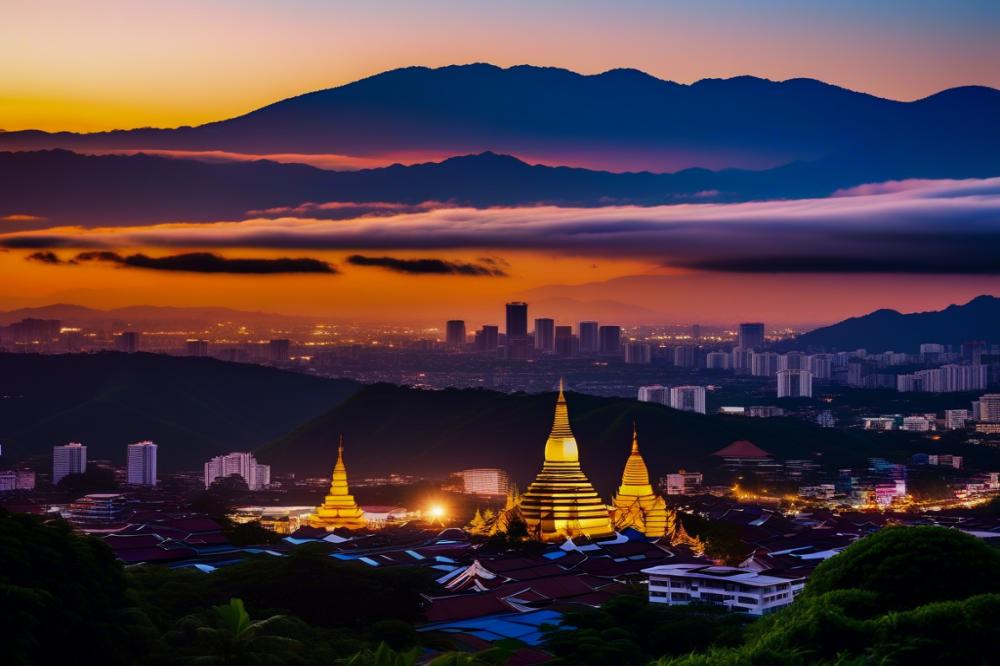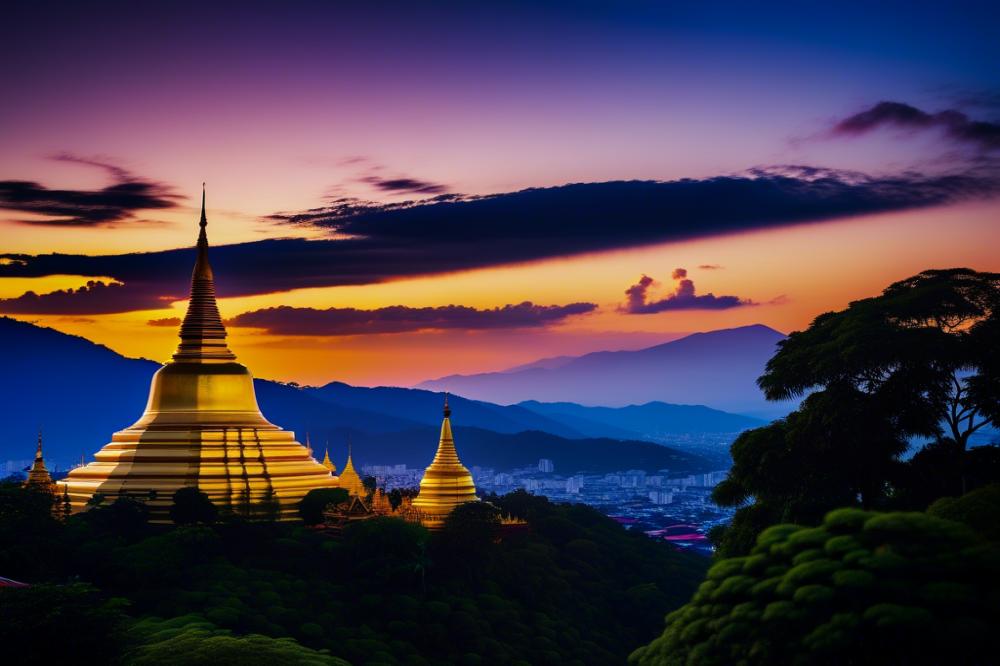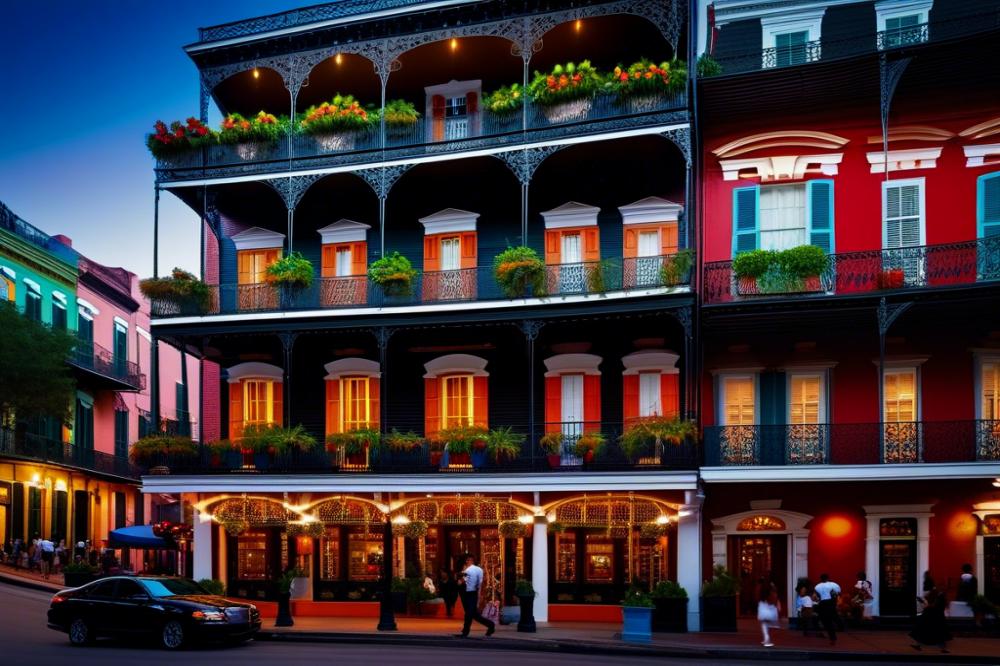Exploring the Ancient Temples of Chiang Mai
Chiang Mai stands out as a stunning travel destination in northern Thailand. This charming city blends modern life with deep cultural roots. Nature lovers and adventure seekers flock to its beautiful mountains and lush landscapes. It offers the perfect backdrop for a memorable vacation. However, it is the remarkable temples that truly capture the heart of Chiang Mai.
Rich in history, the Chiang Mai temples are revered for their architectural beauty and spiritual significance. Each temple serves as a gateway into the past, revealing stories of the Lanna Kingdom and its Buddhist traditions. Visitors can find themselves immersed in the tranquil atmosphere that surrounds these sacred sites. Wat Phra That Doi Suthep, perched high in the mountains, is often the crown jewel of these historical treasures. Believed to house relics of the Buddha, it attracts both worshippers and curious tourists alike.
Temples play a vital role in Lanna culture and Thai heritage. These edifices are not just places of worship; they symbolize community, tradition, and a way of life. Pilgrimages to places like Wat Chedi Luang and Wat Phra Singh connect people to their roots and offer a glimpse into the country’s spiritual heart. Engaging with local monks and participating in temple tours can enhance cultural exploration, allowing travelers to grasp the essence of Buddhist practices.
Tourist attractions in Chiang Mai extend far beyond beautiful landscapes. They encompass the stories and ideologies behind ancient architecture that tells tales of devotion and resilience. By visiting these sacred spaces, individuals gain a deeper appreciation for the region’s heritage. Whether you seek peace or knowledge, the ancient temples await, ready to share their wisdom with all who enter.
Chiang Mai temples: A Journey Through Time

The history of temples in Chiang Mai is rich and extensive. Founded in 1296, the city was once the capital of the Lanna Kingdom. Many structures were built during this time, showcasing the influence of Buddhism. Temples served as spiritual centers and community hubs. Over the centuries, they have experienced renovations and restorations, preserving their significance in modern times.
Temples play an essential role in Buddhist traditions. They are places of worship, meditation, and reflection. Festivals and ceremonies often take place within their walls. In addition, they provide a space for monks to live and practice their faith. The teachings of Buddhism are deeply intertwined with daily life in Thailand. This connection enriches cultural exploration for visitors.
Architectural Diversity of Chiang Mai Temples
Visitors can marvel at various architectural styles in these historical sites. Wat Phra That Doi Suthep is renowned for its spectacular golden stupa. This temple sits atop a mountain, offering breathtaking views of the city below. Wat Chedi Luang presents a blend of Lanna and early Sukhothai architecture. Its massive chedi stands as a testament to the city’s historical grandeur. Wat Phra Singh is another gem, featuring intricate carvings and beautiful murals.
Each temple tells a story and reflects Thai heritage. Exploring these sites provides insights into the Lanna culture that flourished in the region. Temple tours often include guided explanations, adding depth to the experience. The variety of styles, from classic to contemporary, highlights the evolution of Buddhist architecture.
In summary, the temples of Chiang Mai are not just tourist attractions; they are windows into the past. They embody the spiritual journey of the people. Discovering these sacred spaces offers a unique glimpse into Thailand’s rich cultural tapestry. Each visit can deepen one’s understanding of Buddhist traditions and their significance in everyday life.
Exploring Wat Phra That Doi Suthep

Description and Historical Background
Wat Phra That Doi Suthep sits high on Doi Suthep Mountain, overlooking the city of Chiang Mai. This sacred site was established in the 14th century, making it one of the oldest temples in the region. Legend states that a relic of the Buddha was placed in a stupa there after a white elephant carried it to the mountains and died. Tourists visit this awe-inspiring temple to admire its stunning architecture, which reflects the Lanna culture and Thai heritage. Steps lead to the main shrine, where glimmering gold pagodas capture the eye.
Cultural Significance and Buddhist Practices
Visiting this temple offers a glimpse into the heart of Buddhist traditions. Monks can often be seen chanting and praying, creating an atmosphere of peace and spirituality. Many locals come to pay their respects and perform rituals. During special Buddhist events, crowds gather to celebrate with great fervor. Tourists who want to engage with the culture often join guided temple tours to learn more. The vibrant colors and intricate details of the temple highlight the deep respect for craftsmanship in these historical sites.
Stunning Views and Pilgrimage Experience
The views from Wat Phra That Doi Suthep are simply breathtaking. At sunrise and sunset, the landscape transforms into a sea of gold and green, captivating all who visit. Among the most memorable aspects of this site is the experience of the pilgrimage itself. Visitors may ascend the 306-step staircase decorated with dragons, feeling the anticipation grow with each step. Reaching the temple brings a sense of accomplishment and connection to the past. For many, this journey becomes a highlight of their exploration in the Chiang Mai temples.
Discovering Wat Chedi Luang

Historical Context and Architecture
Wat Chedi Luang dates back to the 14th century. Originally built as a grand temple, it showcases Lanna architecture at its finest. The structure has a soaring stupa that once stood even taller. It was designed to house the ashes of a king. However, earthquakes over the years have taken a toll on this architectural wonder. Today, visitors can see both the beauty and the scars of time. Intricate carvings adorn the walls, telling stories of an era gone by. Walking through the temple feels like stepping into the past.
Importance as a Center for Lanna Culture
This temple serves as a vital part of Lanna culture. It has been a site of worship and learning for centuries. Locals gather here to celebrate important Buddhist traditions. Festivals are held regularly, drawing in crowds from near and far. Unlike many modern tourist attractions, Wat Chedi Luang still vibrates with authentic cultural energy. Visitors witness ceremonies and can even join in. A sense of community thrives in this sacred space, highlighting its significance over time.
Insights into Restoration and Preservation Efforts
Restoration projects have taken place to restore Wat Chedi Luang to its original glory. These endeavors aim to protect the temple for future generations. Local organizations, along with the government, have invested in its upkeep. While preservation can be challenging, it remains a priority. Recognizing the temple as a historical site is crucial. Educational programs promote awareness of Thai heritage. Temple tours often include discussions about these efforts. Engaging with caretakers reveals the ongoing commitment to safeguard this extraordinary structure.
Visiting Wat Phra Singh
Overview of the temple’s history and architecture
Wat Phra Singh stands as a testament to the rich heritage of Lanna culture in Thailand. Founded in the 14th century, the temple has served both as a place of worship and a significant historical site. Those who visit can admire its intricate architecture, characterized by detailed carvings and stunning murals. The main structure, called the Wihaan, features a graceful tiered roof. This aesthetic reflects the unique style of the period, blending influences from various artistic traditions.
Exploring the artistic elements and significance
One of the most striking elements of Wat Phra Singh is the golden Buddha statue, revered by locals and visitors alike. It holds immense importance within Buddhist traditions, representing artistry and devotion. The temple walls are embellished with murals depicting scenes from the life of the Buddha, which tell stories of spiritual significance. Visitors often spend time taking in these artistic details, which highlight the temple’s connection to Thai heritage. The craftsmanship seen in the wood carvings also speaks volumes about the skills of artisans from centuries past.
Role of Wat Phra Singh in local religious practices
Wat Phra Singh plays a vital role in the daily lives of the people in Chiang Mai. It serves as a center for Buddhist rituals and festivals, bringing the community together. Locals often participate in temple tours, especially during major religious celebrations. This involvement enhances bonds among residents and fosters a sense of belonging. Daily rituals at the temple draw in monks and worshippers alike, creating an atmosphere of spiritual dedication. Visitors to the temple can witness these practices, gaining insight into the vibrant religious life that thrives here.
Temple Tours and Cultural Exploration
Popular Temple Tours and Itineraries
Many visitors flock to Chiang Mai for its stunning temples. Organized temple tours provide an excellent way to explore these sacred sites. Highlights often include Wat Phra That Doi Suthep, perched atop a mountain overlooking the city. Wat Chedi Luang and Wat Phra Singh are also popular stops on these itineraries. Guided tours typically feature rich stories about each location. Participants can learn fascinating details about the architecture and religious significance. Some tours even include visits to lesser-known temples, allowing travelers to experience quieter surroundings.
Engaging with Local Culture and Traditions
Immersing oneself in Lanna culture is crucial while visiting Chiang Mai. Local festivals, such as Yi Peng and Songkran, showcase vibrant traditions. Tourists might witness traditional dance performances and elaborate ceremonies at various temples. Local artisans often sell handicrafts nearby, providing a glimpse into Thai creativity. Spending time with residents deepens appreciation for their customs and lifestyle. Engaging in a cooking class or a meditation session at a temple offers personal experiences to remember.
Opportunities for Learning about Buddhism and Thai Heritage
Exploration of Buddhist traditions is a key aspect of visiting the temples. Many temples offer workshops and lectures about Buddhist philosophy. Visitors have the chance to interact with monks and ask about their daily lives. This interaction often leads to valuable insights into the spiritual practices of Thailand. Additionally, museums around the city feature exhibits on Thai heritage and history. These resources enhance understanding of the rich tapestry of life in Chiang Mai. Overall, a visit to these historical sites enriches one’s knowledge and inspires deeper connections to Buddhism and local culture.
Final Reflections on Chiang Mai’s Sacred Treasures
The temples of Chiang Mai hold a significance that extends beyond their stunning architecture. These sites are not only places of worship but also a testament to the city’s rich history and cultural heritage. Each temple, from the majestic Wat Phra That Doi Suthep perched on a mountain to the historic Wat Chedi Luang in the heart of the city, tells a story. They serve as reminders of the artistic skills of past generations and the spiritual beliefs that shaped the region.
Visitors to these magnificent structures often find themselves moved by their beauty. Exploring the intricate designs and serene surroundings can deepen one’s appreciation for Thai culture. It is essential to take a moment to reflect on the values and traditions that these temples represent. By doing so, travelers can foster a connection to the place and its people.
Appreciating these sacred spaces involves more than simply viewing them as tourist attractions. It invites individuals to engage with local customs and respect the practices upheld by the community. Each visit provides an opportunity to learn and understand a way of life that has persisted for centuries. This journey can enrich your experience and enhance your awareness of a vibrant culture.
Tourism plays a crucial role in preserving these historical landmarks. Yet, it is the personal experiences gathered at these temples that truly leave a mark. The legacy of Chiang Mai’s sacred sites extends beyond their physical presence. They inspire a sense of wonder and curiosity among all who visit. By immersing oneself in this captivating environment, memories are created that last for a lifetime.
Ultimately, the ancient temples of Chiang Mai are much more than mere structures; they are living symbols of the city’s past and present. As you wander through these historic sites, take the time to notice the small details—the flicker of candlelight, the scents of incense, and the sounds of prayers being offered. Engaging with this spiritual heritage not only enriches your journey but also fosters a deeper respect for the culture that thrives in this enchanting city.



